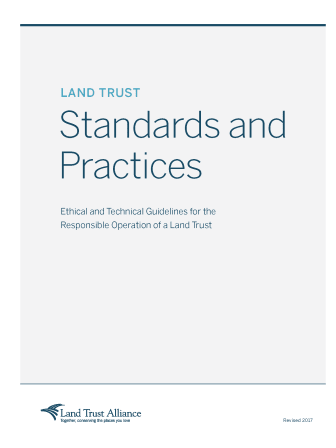Drafting Pointers for Risk Balancing in Conservation
Source
About This Practical Pointer
Suggestions and sample clauses for balancing risk when drafting conservation easements
© 2021 Land Trust Alliance, Inc. All rights reserved.
Explore related resources
Adapting Conservation Easement Drafting to Changing Conditions
Sound conservation easement drafting ensures perpetual protection of the stated conservation purposes of protected land. This pointer addresses drafting future conservation easements assuming increases in impacts from such changes.
Introduction to Risk Management for Land Trusts
An eight-page introduction to principles, tools, frameworks and strategies for risk management
Drafting Approval Standards in Conservation Easements
Ongoing communication between an easement holder and a landowner is critical to ensure that activities on and uses of the land are consistent with an easement's conservation purposes. To effectuate this goal, conservation easements often include clauses governing activities or uses permitted only when the landowner requests the express prior approval of the easement holder. This Practical Pointer contains elements to consider in drafting approval standards.
Balancing Risk on Conservation Easement Modification
A modification clause, which may include amendment, consent, waiver and other discretionary approvals, enhances the 'protected in perpetuity' standard and improves the chances of perpetual easement protection. This clause can help conservation organizations properly address unforeseen circumstances.
A Guided Tour of the Conservation Easement Enabling Statutes
Conservation easement enabling statutes serve as the internal structural frame upon which thousands of easements have been granted. This is a guided tour of all 50 state enabling statutes.
Standing Approved or Denied: Who Has the Legal Right to Sue in Easement Cases
Who has the legal right to sue in conservation easement cases? The Alliance's Conservation Defense team has compiled this list of cases where standing was approved or denied.
Costs and Fees Recovery
The possibility that a land trust could be required to pay substantial fees and costs if it loses a legal challenge can be a significant deterrent. States take a variety of approaches to costs and fees, so as a first step, land trusts should have experienced local counsel in their state determine what the standard practice or statute is so that you can draft to prevail on the fee recovery clause, without exposing your land trust to prevailing party risks.
Sample for Practice 11F: SPNHF Discretionary Consent Policy
This conservation easement discretionary consent policy from the accredited Society for the Protection of New Hampshire Forests.

Practice 9H: Purchasing Land or Conservation Easements
This guidance covers Practice 9H: Purchasing Land or Conservation Easements.